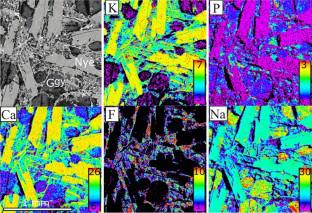Contributions to Mineralogy and Petrology ( IF 3.5 ) Pub Date : 2023-06-19 , DOI: 10.1007/s00410-023-02021-z
Céline Baudouin , Lydéric France

|
Trace-element partitioning between gregoryite, nyerereite, and natrocarbonatite melt is primordial for understanding trace-element distribution and fractionation in alkali-rich carbonatites. However, trace-element data are scarce for gregoryite and nyerereite. Here, we provide the first partition coefficients and lattice strain model parameters for trace-element partitioning between these carbonate minerals and natrocarbonatite at Oldoinyo Lengai (Tanzania). Nyerereite and gregoryite phenocrysts crystallize within a shallow magmatic reservoir (< 3 km depth, ~ 600 °C), and gregoryite continues to crystallize during magma ascent at lower pressures. At these low-temperature and pressure conditions, trace elements behave incompatibly in both gregoryite and nyerereite. Trace-element partitioning is characterized by a parabolic fit between the partition coefficients and ionic radii that is explained by a lattice strain model in which the site radius (r0) decreases with increasing charge from r01+ = 1.1 Å to r04+ = 0.75 Å. We observed different partition coefficients in gregoryite (Ggy) and nyerereite (Nye): those in nyerereite are greater than those in gregoryite for REEs (\({D}_{Nd}^{Nye}\)= 0.58 vs. \({D}_{Nd}^{Ggy}\) = 0.21; \({D}_{La}^{Nye}\) = 0.27 vs. \({D}_{La}^{Ggy}\) = 0.12), Sr (\({D}_{Sr}^{Nye}\)= 0.92 vs. \({D}_{Sr}^{Ggy}\) = 0.5), Ba (\({D}_{Ba}^{Nye}\)= 0.22 vs. \({D}_{Ba}^{Ggy}\) = 0.1), and Rb (\({D}_{Rb}^{Nye}\)= 0.35 vs. \({D}_{Rb}^{Ggy}\) = 0.26), but lower for HFSEs (e.g., \({D}_{Hf}^{Nye}\) = 0.13 vs. \({D}_{Hf}^{Ggy}\) = 0.28; \({D}_{Nb}^{Nye}\) = 0.02 vs. \({D}_{Nb}^{Ggy}\) = 0.08). Because all trace elements are incompatible, their concentrations increase in the melt during differentiation and the crystallization of both gregoryite and nyerereite. Due to their different partition coefficients, we can constrain the shallow crustal crystallization history of natrocarbonatite melts at Oldoinyo Lengai: the crystallization of roughly equal proportions of gregoryite and nyerereite can produce aphyric natrocarbonatite compositions from a typical natrocarbonatite composition. The late-stage crystallization of gregoryite alone during magmatic ascent and eruption can significantly impact the concentrations of key elements, such as increasing LREE contents and LREE/HFSE and LILE/HFSE ratios in the residual melt. Our results also highlight that natrocarbonatite melt crystallization during the 2019 eruption proceeded at temperatures from 600 °C to as low as 300 °C.
中文翻译:

砾石、尼雷石和钠碳酸盐岩熔体之间的微量元素分配:对钠碳酸盐岩演化的影响
砾石、尼雷石和钠碳酸盐岩熔体之间的微量元素分配是了解富碱碳酸岩中微量元素分布和分馏的基础。然而,长石和尼雷石的微量元素数据很少。在这里,我们提供了 Oldoinyo Lengai(坦桑尼亚)这些碳酸盐矿物和硝基碳酸岩之间微量元素分配的第一个分配系数和晶格应变模型参数。尼瑞石和砾石斑晶在浅层岩浆储层(< 3 km 深度,~ 600 °C)内结晶,而砾石在较低压力的岩浆上升过程中继续结晶。在这些低温和压力条件下,微量元素在滑砾石和尼雷石中表现得不相容。r 0 ) 随着电荷的增加而减小,从r 0 1+ = 1.1 Å 到r 0 4+ = 0.75 Å。我们观察到细长石 (Ggy) 和尼雷石 (Nye) 中的分配系数不同:对于 REE,尼雷石中的分配系数大于细长石中的分配系数 ( \({D}_{Nd} ^{Nye}\) = 0.58 vs . \({ D}_{Nd}^{Ggy}\) = 0.21; \({D}_{La } ^{Nye}\) = 0.27对比\({D}_{La}^{Ggy}\) = 0.12), Sr ( \({D}_{Sr}^{Nye}\) = 0.92 vs . \({D}_{Sr}^{Ggy}\) = 0.5), Ba ( \({D} _{Ba}^{Nye}\) = 0.22 vs。\({D}_{Ba}^{Ggy}\) = 0.1) 和 Rb ( \({D}_{Rb}^{Nye}\) = 0.35 vs . \({D}_{Rb} ^{Ggy}\) = 0.26),但对于 HFSE 较低(例如,\({D}_{Hf}^{Nye}\) = 0.13与\({D}_{Hf}^{Ggy} \ ) = 0.28; \({D}_{Nb}^{Nye}\) = 0.02与\({D}_{Nb}^{Ggy}\)= 0.08)。由于所有微量元素都是不相容的,因此在辉长岩和尼雷石的分化和结晶过程中,它们的浓度在熔体中增加。由于它们不同的分配系数,我们可以限制Oldoinyo Lengai的碱式碳酸盐岩熔体的浅地壳结晶历史:大致相等比例的砾石和尼雷石的结晶可以从典型的碱式碳酸盐岩组合物中产生非非晶状碱式碳酸盐岩组合物。在岩浆上升和喷发过程中,仅砾石后期结晶就可以显着影响关键元素的浓度,例如残余熔体中轻稀土含量以及轻稀土/HFSE和LILE/HFSE比率的增加。

































 京公网安备 11010802027423号
京公网安备 11010802027423号